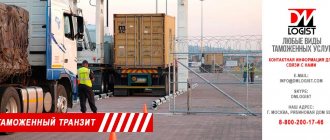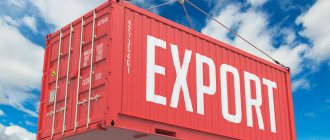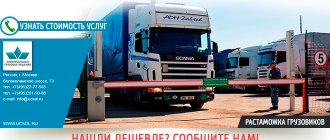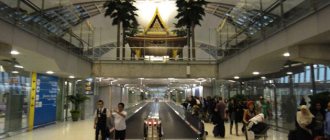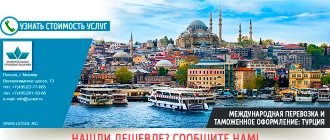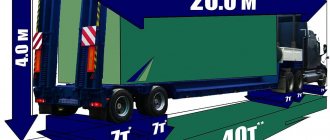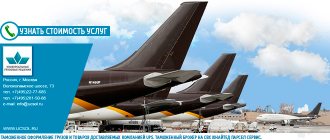Internal customs transit of goods, or ICT, is a customs procedure (newly customs transit) used when transporting foreign goods across the territory of the Customs Union. Cargoes placed under the VTT customs procedure are not subject to customs duties and taxes.
The customs procedure for internal customs transit of goods was used by participants in foreign economic activity (FEA) until 2010. Then, after Russia joined the EAEU, the “Customs Code of the Russian Federation”, which had been in force since 2003, was replaced by the “Customs Code of the Customs Union”. The new main customs law abolished the procedures for domestic and international customs transit, combining them within the framework of customs transit. This provision was preserved in the Customs Code of the Eurasian Economic Union, which replaced it in 2021, therefore today all foreign goods transiting through our customs territory are placed under the customs procedure of customs transit (procedure 80).
Sample of a completed transit customs declaration – View
Sample inventory for a transit customs declaration – View
In what cases are goods placed under this customs procedure?
Internal customs transit is used when transporting goods from abroad:
- From the customs office of arrival to the internal customs authority of any country participating in the Customs Union, or vice versa;
- Between temporary storage warehouses (customs warehouses).
When transporting goods by air, the internal customs transit procedure is not used (provided that the goods were not unloaded from the ship). A similar rule applies when moving goods through pipelines and power lines.
Customs control measures:
- Guarantee obligations of the declarant for payment of import customs duties;
- Cargo escort (carried out at the expense of the declarant);
- Route development.
After receiving a transit customs declaration and all shipping documents from the declarant, the customs authority of the place of departure issues a permit for internal customs transit. This document contains information about the place of delivery of goods and the duration of transit.
Upon arrival of transit cargo at the customs control zone of the customs office of destination, the transit customs declaration is terminated and the declarant is issued a certificate of completion of the internal customs transit procedure.
Transit conditions
- Provide the specified documents confirming the security of payment of customs duties at the customs point of arrival;
- A customs carrier certificate should be included in a special package of documents, since transportation can only be carried out by the activities of vehicles of a certified international carrier.
- Identification of foreign goods (including sea goods) and admission of employees to the inspection of declared goods and the procedure (wtt customs) for customs transit clearance;
- Compliance with other conditions provided for by the Customs Code and agreements between the countries of the Customs Union
A permit for customs transit and a customs declaration are issued after submitting a transit customs declaration and all documents for the goods. The permit and registration reflect the answers to questions such as the place of delivery of goods and the duration of transit. Registration of international internal customs transit occurs in stages. It begins with registration at the point of arrival and deregistration in the control zone before leaving Russian territory.
Customs transit time
Customs authorities, based on legislation and information about the route and type of product, calculate the transit period. The deadline takes into account all labor standards, including destination, drivers' working hours and mandatory rest.
Ensuring customs transit
In addition to calculating the route, customs duties and supporting the customs transit procedure, it is necessary to financially ensure the payment of all customs duties in one of the following ways:
- pledge of client's goods or other property
- a security payment is made in favor of the Federal Customs Service to the account of the Federal Treasury
- consent and guarantee of the bank
- obtaining a guarantee
Internal customs transit (ICT)
Internal customs transit (ICT) is a customs procedure in which foreign goods are transported through the customs territory of the Russian Federation without paying customs duties, taxes and the application of prohibitions and restrictions of an economic nature established in accordance with the legislation of the Russian Federation on state regulation of foreign trade activities.
Reasons for registering the VTT procedure.
Internal customs transit is used when delivering goods that have not cleared customs from the place of their import into the territory of Russia to their destination (customs declaring authority).
Why do some importers do not clear the cargo at customs at the port (at the border), but transport it under customs control to the customs post at the destination. There are several reasons for this:
- Preferences for a specific importer or his broker when clearing goods at a specific customs post.
- Poor clearance history and problems with proving customs value at the customs post at the border crossing.
- Certain groups of imported goods are processed only at specialized customs posts, and not at the border crossing point. For example: excisable, exhibition, diplomatic goods.
- Administrative regulation by the state for particularly large participants in foreign trade activities and residents of special economic zones in terms of the distribution of payments between customs.
Delivery deadlines for customs transit (CT).
When exporting standard cargo by road, the customs transit period is calculated at the rate of 400 km per day in summer, 300 km per day in winter. This is the maximum delivery period, if exceeded, an administrative case may be opened for violating the rules for the transportation of transit goods. Of course, in fact, the lion's share of the car arrives at the customs post ahead of schedule.
For example, TT terms for container delivery along the route:
- port of St. Petersburg or Ust-Luga – Moscow – 2 days;
- port Novorossiysk – Moscow – 4 days.
When exporting oversized and dangerous goods accompanied by the Federal Customs Service, it is guided by recommendations on delivery times from regulatory authorities.
When exporting by railway, they are guided by the train formation plan and the declared transit time by the railway system with a small margin. In practice, this turns out to be around 100 – 150 km per day.
List of documents for registration of customs transit at the port.
- Bill of lading (original);
- Invoice (copy), which should reflect the following information:
- invoice number and date;
- sender;
- recipient;
- contract number;
- delivery conditions;
- Name of product;
- number of seats, net and gross weight;
- price;
- HS Code.
- Packing list (copy), containing information about the weight and quantity of the goods, if they were not reflected in the invoice, as well as the container number, for container cargo;
- Certificate from the statistical office with OKPO code and legal address (copy);
- Certificate from the tax office with TIN code (copy);
- Power of attorney for the right of forwarding and customs clearance (original);
- Transport expedition agreement (copy);
- At the request of customs, depending on the cargo, it is possible to provide additional documents. For example: certificate of state registration of products, certificate of origin, sanitary and epidemiological conclusion, veterinary certificate, etc.;
- Full details of the customs post of destination and temporary storage warehouse with license number;
- Address and contact person at the unloading warehouse (working schedule).
Guarantee of customs transit
Transportation in customs transit mode through the territory of the Customs Union (CU) guarantees delivery of uncleared goods to the customs post of destination and, in case of non-delivery, the state will not suffer damage in the amount of unpaid customs duties, fees and taxes.
Security for the payment of customs duties can be provided by any of the methods provided for by the customs legislation of the Customs Union:
- in cash (money),
- bank guarantee,
- guarantee,
- pledge of property.
Participants in foreign economic activity can also use the services of customs carriers. In this case, provision of security for the payment of customs duties and taxes during customs transit of goods is not required.
The right to choose the method of ensuring customs transit is given to the declarant. In addition to the declarant, TT security may be provided by another person if this person has the right to own, use or dispose of the goods being transported.
Thus, the importer can also provide security for the carrier, taking into account the fact that the security can be presented to both the customs authority of departure and the customs authority of destination.
The procedure for providing and accepting security is determined by Articles 140, 141, 145 and 146 of the Federal Law of November 27, 2010 No. 311-FZ “On Customs Regulation in the Russian Federation”.
It is advisable to provide security in advance, even before the import of goods, which will eliminate cases of vehicle downtime at checkpoints associated with the registration of security when the transit procedure opens.
Credo Trans company has its own bank guarantee in the amount of 50,000,000 rubles to ensure transit transportation of containers with goods of its customers from the ports of St. Petersburg, Bronka, Ust-Luga and Novorossiysk to customs posts close to the importers' warehouses.
Based on our bank guarantee, a guarantee certificate for each specific batch of imported goods, which is subsequently provided to the customs office of departure upon application for the customs transit procedure.
Cost of customs transit clearance at Credo Trans
offers a service for processing international and domestic customs transit (CT) in the ports of St. Petersburg, Ust-Luga, Bronka and Novorossiysk. Registration of customs clearance is carried out as part of a complex of all measures for transporting goods under customs regime.
For example, the cost of services for registration of VTT and delivery by motor transport in TT mode along the route: St. Petersburg seaport - temporary storage warehouse in St. Petersburg - unloading at the consignee's warehouse in St. Petersburg for a 1x40HC container weighing up to 20 tons - 35,000 rubles (VAT exempt).
Rate includes:
- issuance of a warranty certificate;
- obtaining permission for customs transit;
- removal of uncleared goods from the port to another customs warehouse in the TT regime;
- delivery of customs cleared goods to the client’s warehouse
- delivery of the empty container to the line depot;
The free period for using the vehicle from the moment of arrival at the terminal until the moment of unloading at the warehouse is 2 days.
Cost of vehicle downtime beyond the free period:
- for the 3rd day – 10,000 rubles
- from 4 days – 13,000 rub/day
The indicated rates are valid until 31/03/2019
To calculate the cost of export in TT mode to the regions from the ports of St. Petersburg, Ust-Luga, Bronka and Novorossiysk, please contact the company’s sales department.
Other types of our services:
- Container sea transportation of goods
- Freight forwarding at the port
- Road transportation of containers
Required documents
- Invoice
- Monitoring the availability of a packing list with information about the product and organization
- In this case, copies of tax documents (TIN, OGRN, OKPO) are also required.
- Agreement with the carrier performing the transportation; documents for the driver with transport
- Waybill
- Customs carrier certificate
- Customs declaration indicating the code of the customs post
For dangerous goods, animals and plant cargo, in addition to the transit declaration, permits and certificates will be required.
Completion of the internal customs transit regime
After completion of transportation of the cargo to the internal customs office (SWH), the transit declaration is terminated, and a certificate of compliance is issued on the completion of customs transit.
Peculiarities
International transit (ITT) and the internal customs transit procedure (ICT) within the framework of the union of legislation of the EAEU Customs Code were combined into one procedure - internal customs transit. The customs procedure is selected by the declaring person based on the necessary tasks and represents a set of conventions and standards for their legal compliance.
Transportation of goods in the VTT mode: subtleties and nuances
Transportation services under internal customs transit are used in a number of cases:
- Transportation from the point of arrival to the place of customs control.
- Wrong arrival of cargo at another post.
- Transportation between temporary storage warehouses.
Such goods were not subject to customs clearance. This means that despite their location on the territory of the Russian Federation, they are not released into free circulation. This status requires special control.
Transportation of goods in the VTT mode is applicable to any groups of goods. Products must meet the following conditions:
- Has an import permit.
- Not prohibited by Russian legislation.
- Accompanied by the necessary documents.
- Passed sanitary and veterinary control.
- Retained customs seals.
- Products have been identified.
The time frame for transporting goods in the VTT mode is determined by the customs authority, which is responsible for issuing permits. The duration varies depending on the method of transportation.
Procedure, features, nuances of VTT
Delivery and customs clearance of goods require passing through several customs procedures. Permission to conduct the VTT verification process is issued by the authorized customs authority on the part of the consignor. The basis for the permit are guarantee documents indicating full payment of duties (payments). Such documents may include:
- warranty certificate;
- certified receipt;
- customs escort.
The procedure is systematized in full compliance with the strict rules of the Federal Customs Service. The inspection is carried out by an inspector who issues a declaration for the cargo. It is possible to go through (carry out) intra-customs transit in any of the terminals suitable for VTT. As a rule, terminals are divided into:
- land-based - traditionally located in the border zone, operating on a commercial (paid) basis;
- airport - terminals operating only at airports; the service is also commercial, i.e. paid.
Based on practical experience, the conclusion follows: going through the BTT procedure in a ground terminal is much more profitable. In a ground terminal, the process is faster and the cost is lower than in airport terminals. After the final completion of the VTT, the transported cargo is cleared at customs by the recipient.
The most typical cases of using VTT:
- upon delivery of cargo from the place of arrival to the point of customs clearance;
- from the customs control zone when declaring goods to the point of crossing the border of the customs territory of the Russian Federation (in particular, when registering the export of processed goods of non-residents);
- from one temporary storage warehouse (customs warehouse) to another (if the activity of the warehouse is terminated or limited, and the cargo located there has not passed the declaration procedure);
- in case of failure to comply with the requirement to provide security for the payment of prescribed payments for goods of foreign origin.
As part of the internal transit procedure, interested parties are exempt from collecting fees and charges, and the availability of certificates for the product being moved is not checked. The authorized customs authority at the place of departure of the cargo clearly determines the deadline for transit transportation to its destination.
Calculation of the cost of cargo delivery
Calculate the approximate cost of cargo delivery by our company to Moscow
cost of delivery of your goods
will be:15,960€
Order
cost for a tilt car 82m3 This calculation is approximate and may vary up or down depending on seasonal and economic factors. Check with our specialists for the exact cost.
Application for cargo delivery services
Cancel
Thank you! Your application has been received, we will contact you soon!
Transit as an object of regulation
The concept of transit characterizes the movement of a vehicle with cargo between points of departure and destination with additional control at an intermediate customs point as part of export-import operations. As a rule, most types of transit operations are strictly regulated by government agencies of the territory being crossed. The legislation of the Russian Federation provides for a number of separate procedures, requirements and restrictions both in relation to certain product groups, countries of origin, methods and means of transportation, and the procedure for implementing measures to ensure transit security. One of the private types of the latter - internal customs transit - is also carried out on the basis and in the manner determined by the legal field of the state.
Get a detailed and free consultation
Thank you for contacting our company! Our manager will contact you soon
Help from professionals in registering VTT
Most often, the need to formalize internal customs transit arises during international transfers of goods received or sent via air transport.
In this regard, for the convenience of clients, the work of brokers has been established at the main customs air terminals of the country. In order not to get lost in the labyrinths of legislation and not to lose sight of the essential points in the process of internal movement of goods, we advise you to contact experienced customs market operators. Here you will find qualified assistance in preparing documentation and obtaining permission for internal customs transit in accordance with the rules and regulations of the Russian Federation and the Customs Union.
Required documentation for VTT
The recipient, as well as the sender, of a certain cargo during the VTT procedure is required to have a certain package of documents that should be provided to the customs inspector. The documentation package includes:
- originals of consumables and accompanying documentation for the transported cargo (goods) - invoices, codes, specifications, invoices, etc.;
- original documents for the transport itself carrying the cargo - VIN of the cargo transport vehicle, TIR Carnet, power of attorney for the driver himself, CMR;
- TIN certificate confirming mandatory registration with the tax service;
- copies of registration documentation of the sender and recipient organizations, copies of OGRN, certified by enterprises;
- OKPO certificate (copy), necessarily certified by the company (enterprise);
- a photocopy of the official license, certified by the customs office that issued it;
- a copy of the contract for the supply of cargo, certified by the recipient company (enterprise);
- official agreement with a customs broker;
- original official general power of attorney for freight forwarding services (if a hired company is engaged in transporting goods).
It doesn’t matter where customs clearance : China , Russia or Australia. A professional logistics company with a large staff of specialists who can understand all the nuances of passing the VTT and many other issues related to foreign trade and foreign economic activity, and in particular, with the urgent delivery of goods from China, is quite capable of providing effective assistance in passing the VTT.
As personal experience has shown, the VTT on the Chinese-Russian border is very difficult to pass. I contacted you and the goods arrived almost without delay. Long, but within reason. I hope that the passage procedure will be carried out faster next time. I plan long-term cooperation. Thank you.. Zabarny N.V
The customs transit procedure is not entirely pleasant for business people, since it takes up their time and can have a negative impact on the timeliness of delivery. The more valuable is your assistance in customs and logistics services. By wasting less time at customs, your employees also developed the optimal route for my orders. It is effective and therefore profitable. I hope to continue cooperation with you.
